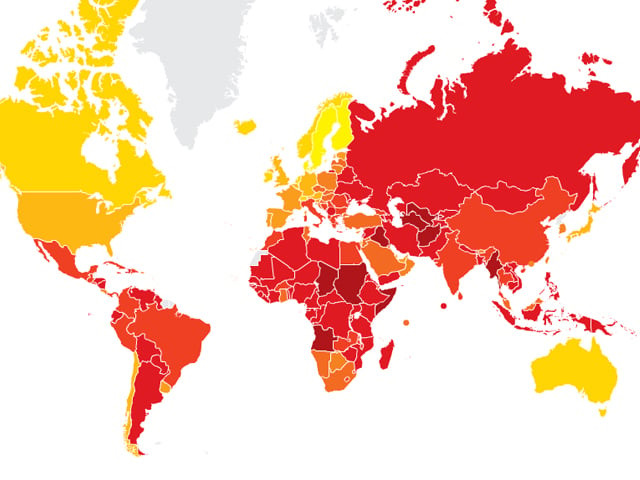
Other reprimands on how the Congress government has misgoverned have surfaced too. A US-based research group says India lost an estimated $462 billion taken out illegally in the past 60 years. Significantly, tax evasion and corruption have increased after India got rid of its low-growth ‘licence-raj’ economy in 1991. Unlike Pakistan, however, the corruption has surfaced mostly in the private sector where tax evasion and under-invoicing (exports) and over-invoicing (imports) are rampant.
Some other India scams are worth mentioning. The recent Commonwealth Games exposed India to global ridicule when the arena was found to be defective because of corruption in the award of contracts. Ashok Chavan, chief minister of Maharashtra, was involved in the Adarsh scam worth billion of rupees, a housing programme meant for the families of the martyrs of the Kargil war of 1999 but where the flats were sold to undeserving individuals. If one were to think that the Pakistani judiciary is corrupt then they should hear this: in 2008, the then Chief Justice of India Justice KG Balakrishnan wrote to the prime minister recommending that proceedings be initiated for the removal of Justice Soumitra Sen, judge, Calcutta High Court, for corruption.
Justice Nirmal Yadav of the Punjab and Haryana high court was found indulging in forgery and abuse of his official position as a judge while buying land in Solan in the adjoining state of Himachal Pradesh. In 2008, a sum of Rs1.5 million in cash was mysteriously delivered at the residence in the same city, Chandigarh, of another judge of the high court, Justice Nirmaljit Kaur. This could be just the tip of the iceberg of corruption in India’s 28 high courts.
Comparison with Pakistan is inevitable but we undertake it usually for two purposes: one, to satisfy our ill-will against India as the ‘enemy state’ apparently going down the tubes; and two, to lighten the burden of guilt of our own corruption in Pakistan saying so what if we are corrupt, India is corrupt too. Tragically, there is a third way of looking at it: corruption is rampant in both India and Pakistan but India is steadily seen as a successful state while Pakistan seems to qualify as a ‘failing state’. Transparency International has ranked India 87th out of 178 countries on its 2010 International Corruption Perceptions Index. Pakistan was the forty-seventh most corrupt state in the world in 2009; it has become the forty-second most corrupt in 2010. In two years, we have broken some past records of our own. The scale, no doubt, is different when framed against the growth rates posted by the two countries.
There is more to read about India if we want to correct our perspective on Pakistan. The corrective is aimed at the Pakistani obsession that every case of scam must lead to collapse of the state at the highest point of imagination and a mid-term change of government at the lowest. The mind is so used to ‘toppling’ of elected governments by the army in the past that we have lost our faith in democracy and want to return to a military or quasi-military rule where we perceive less corruption. India, like Pakistan, is a non-exporting country. Its taxation system is as defective as Pakistan’s. Its infrastructure is abysmal just like Pakistan’s and service delivery and other issues of outreach are as poor, if not more.
The economist in Pakistan complains that the retail sector pays hardly any tax. The retailing sector of India can be split into two segments — the informal and the formal — and the former, comprising small retailers, pay no taxes. In terms of value, the Indian retail industry is worth $300 billion and its contribution to India’s gross domestic product stands at 10 per cent, the highest compared to all other Indian industries. What about loss-making in the state sector of the economy? In Pakistan all state-owned corporations account for a whopping Rs400 billion loss to the exchequer every year because of the frequent bailouts when there is debt-overhang from money payable to the oil sector.
Not all of India’s state sector economy is something to write home about. Out of the 48 units deemed “troubled”, seven have been identified as loss-making and fit for closure, while divestment is seen as the only option to revive another batch of 11 in the red. There are nine profitable companies that won't be touched. About 17 units are under scrutiny for options of revival ‘by inviting support from private sector’. Yet what is it that makes the world think India is ‘shining’ while Pakistan is experiencing a never-ending eclipse?
Pakistan is different from India only in its problem of law and order which is undermined by terrorism which, in turn, appears to the world as embedded in the state structure itself. Why does the world think the state in Pakistan is the epicentre of terrorism radiating threat to other states? Because the state in Pakistan has used non-state actors in its policy of jihad and will not — or is unable to — act against the UN-banned terrorist organisations on its soil. Furthermore, because of its earlier policy of deploying jihadi organisations, it has created centres of power inside the country it can no longer control. Some observers, and this may include a few inside Pakistan as well, are of the view that the writ of the state no longer works or is absent in a large chunk of the country’s territory. That is definitely not the case with India.
Published in The Express Tribune, November 25th, 2010.












COMMENTS
Comments are moderated and generally will be posted if they are on-topic and not abusive.
For more information, please see our Comments FAQ